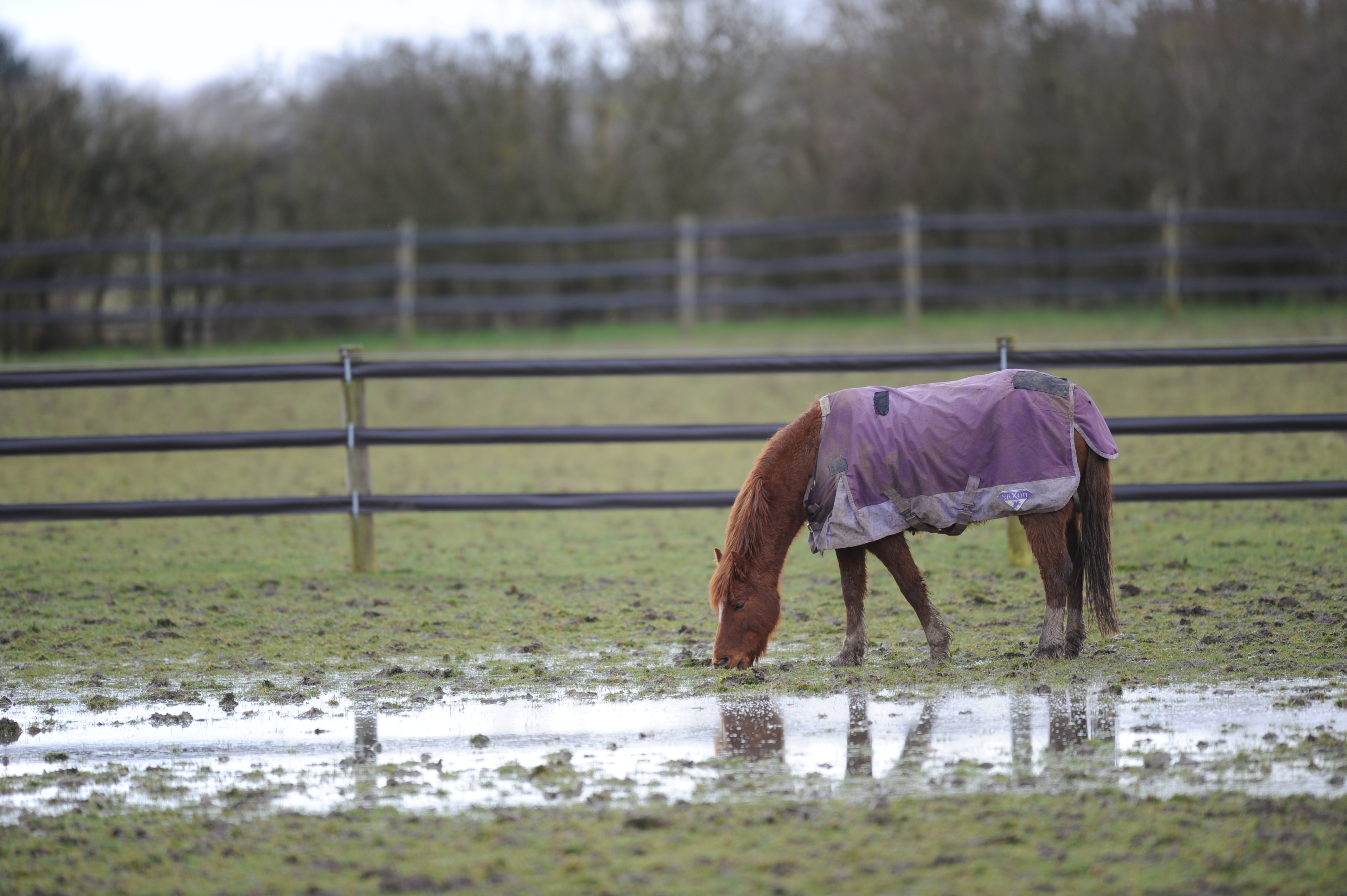
Caring for your horse in wet weather
Wet weather in the UK can be a problem for both you and your horse.
While horses are naturally well-equipped to deal with bad weather, there are steps you should take to keep your horse happy and healthy during periods of rain and wet ground.
Managing muddy areas
Managing mud in your horse's field can be difficult. Preparing the area around your gateway can help, as this is where mud is likely to be most challenging. To do this, you can:
- Place heavy duty grass mats in the gateway area ‒ this works well for some fields and can prevent the area from becoming too slippery. Grass mats can also be placed in areas that have already become very muddy.
- Create two gateway areas, so you have another option if your main gateway becomes too muddy. Electric fencing can also create a second gateway.
- Place hay or boredom breakers, such as treat balls, away from the gate area to prevent your horse from using the area and making it boggier
It's best to prepare your gateways sooner rather than later, as this will prevent the field from becoming too muddy.
Mud fever in horses
Mud fever is a painful skin condition, which can affect your horse's lower legs and heels. It can be caused by standing in wet or muddy areas for long periods of time.
Mud fever symptoms
If your horse has mud fever, they may develop the following symptoms on their lower legs or heels:
- crusty scabs
- discharge under the scabs
- broken or damaged skin
- heat in the lower leg
- lower leg may swell in severe cases
Important
Check your horse's legs daily for signs of mud fever and contact your vet if you are concerned. The quicker you spot mud fever, the easier it is to treat.
Preventing mud fever
Wet conditions during the winter months can increase your horse's risk of developing mud fever. Here are some steps you can take to prevent it:
- If your horse is stabled at night, wash down their legs to remove any mud, but remember to dry them off thoroughly – it will be easier to do this if your horse's legs and heels are clipped. You can also leave the mud to dry and brush it off with a soft brush.
- If you're bringing your horse in, make sure that their stable area is dry and remove wet bedding daily
- If your horse has clipped legs, you can apply a barrier cream to protect their skin from any mud. Just remember to make sure that your horse's skin is dry beforehand, as wet legs can cause bacteria to build between the skin and the cream.
- You can also spray pig oil onto clipped legs, to prevent mud from sticking
- Using water-resistant, breathable turnout boots can protect your horse's legs, as long as the boots are fitted correctly and your horse is used to wearing them
Rain scald in horses
Rain scald is a non-contagious skin infection that causes small scabs to form on your horse's back, neck and hind quarters.
Similar to mud fever, it's caused by too much exposure to wet conditions. However, it can also develop from leaking or non-breathable rugs, as this can cause your horse's back to become constantly wet from rain or sweat.
Preventing rain scald
You can help to prevent rain scald by:
- making sure your horse has access to shelter at all times, including natural shelter from trees and hedges
- ensuring that rugs used are correct for the conditions and that your horse is not over-rugged if the weather is mild
- bringing your horse in to allow their skin to dry, if possible
Check your horse's hooves
It's important to check your horse's hooves daily, especially during wet weather. Standing in constant wet and muddy ground can cause thrush in your horse's hooves ‒ a bacterial infection that leaves a foul-smelling discharge.
If you suspect your horse may have thrush, contact your vet.
Should I rug my horse in the rain?
When the weather is wet, it's best to rug appropriately for your horse. Not all horses need a rug in the rain, and it's important to remember that over rugging can cause your horse to sweat. However, if your horse is elderly or sensitive to the cold, they may appreciate a rug.
If you do rug your horse in the rain, it's also a good idea to have two rugs to allow them time to dry off.
Read more about how to rug your horse.
Enrichment in wet weather
Providing your horse with plenty of enrichment will keep them occupied on occasions when they may need to be stabled. Treat balls and foraging can also encourage your horse to stay away from muddy areas within their field.
Take a look at our enrichment activities.
Grooming your horse
If your horse lives in a field all year round, it's best to leave any mud on their coat alone, as this can help to protect their coat from the harsh weather. However, you will need to groom your horse if you are planning to ride, to prevent the mud from rubbing your horse when tacked up. This is especially important for areas where the saddle, bridle or boots sit.
If your horse is stabled, it's a good idea to dry them off and brush mud from their coat when they come in for the night. This will help to keep them comfortable and healthy.
Tip
Remember to keep lots of dry towels to hand during wet weather, so you can always dry your horse's legs.
Prepare for flooding
It's important to be prepared for flooding on your yard or field, especially if you know that the area is prone to flooding. Make sure you have an evacuation plan in place for moving your horse if needed. It's also best to remove any equipment, hay or feed from the area.
Page details
Reviewed
• 19 July 2023
Next review
• 17 July 2026




